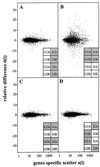Significance analysis of microarrays applied to the ionizing radiation response
- PMID: 11309499
- PMCID: PMC33173
- DOI: 10.1073/pnas.091062498
Significance analysis of microarrays applied to the ionizing radiation response
Erratum in
- Proc Natl Acad Sci U S A 2001 Aug 28;98(18):10515
Abstract
Microarrays can measure the expression of thousands of genes to identify changes in expression between different biological states. Methods are needed to determine the significance of these changes while accounting for the enormous number of genes. We describe a method, Significance Analysis of Microarrays (SAM), that assigns a score to each gene on the basis of change in gene expression relative to the standard deviation of repeated measurements. For genes with scores greater than an adjustable threshold, SAM uses permutations of the repeated measurements to estimate the percentage of genes identified by chance, the false discovery rate (FDR). When the transcriptional response of human cells to ionizing radiation was measured by microarrays, SAM identified 34 genes that changed at least 1.5-fold with an estimated FDR of 12%, compared with FDRs of 60 and 84% by using conventional methods of analysis. Of the 34 genes, 19 were involved in cell cycle regulation and 3 in apoptosis. Surprisingly, four nucleotide excision repair genes were induced, suggesting that this repair pathway for UV-damaged DNA might play a previously unrecognized role in repairing DNA damaged by ionizing radiation.
Figures




References
-
- Roberts C, Nelson B, Marton M, Stoughton R, Meyer M, Bennett H, He Y, Dai H, Walker W, Hughes T, Tyers M, Boone C, Friend S. Science. 2000;287:873–880. - PubMed
-
- Galitski T, Saldanha A, Styles C, Lander E, Fink G. Science. 1999;285:251–254. - PubMed
-
- Ly D, Lockhart D, Lerner R, Schultz P. Science. 2000;287:2486–2492. - PubMed
-
- Weill D, Gay F, Tovey M, Chouaib S. J Interferon Cytokine Res. 1996;16:395–402. - PubMed
Publication types
MeSH terms
Substances
Grants and funding
LinkOut - more resources
Full Text Sources
Other Literature Sources
Medical
Research Materials

